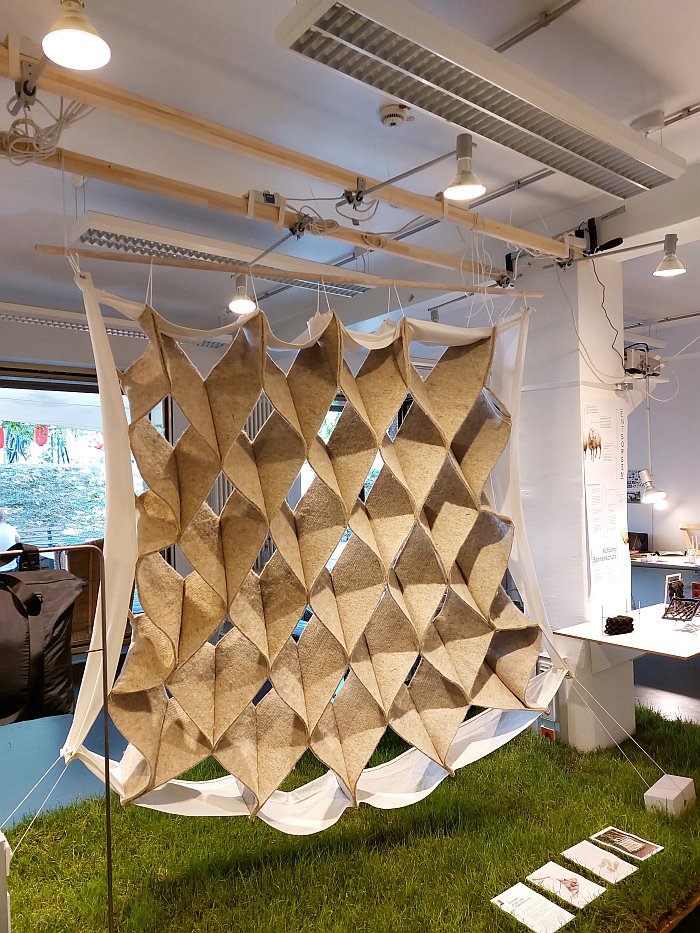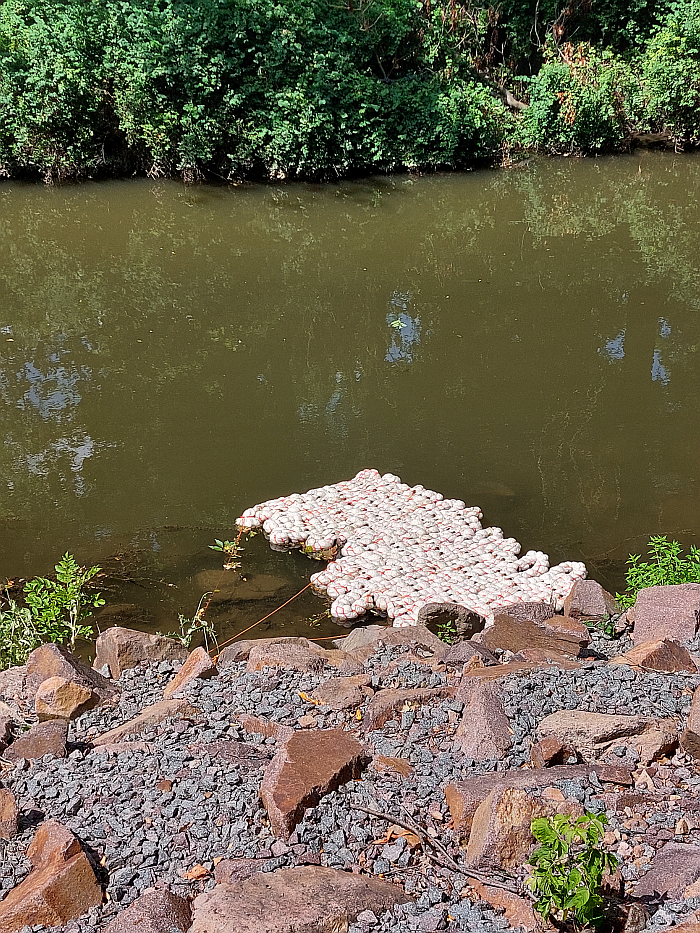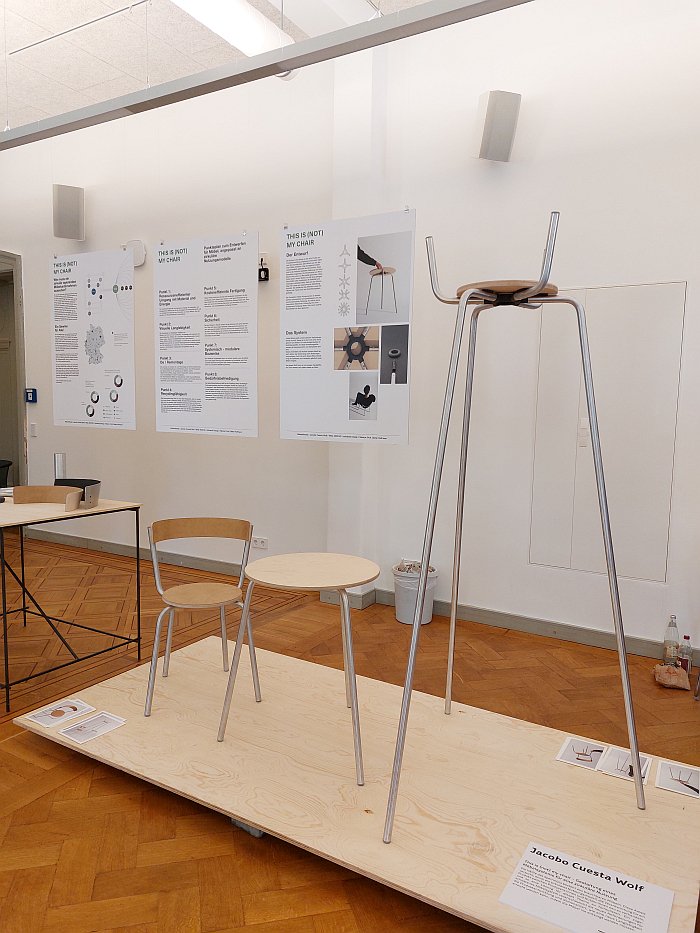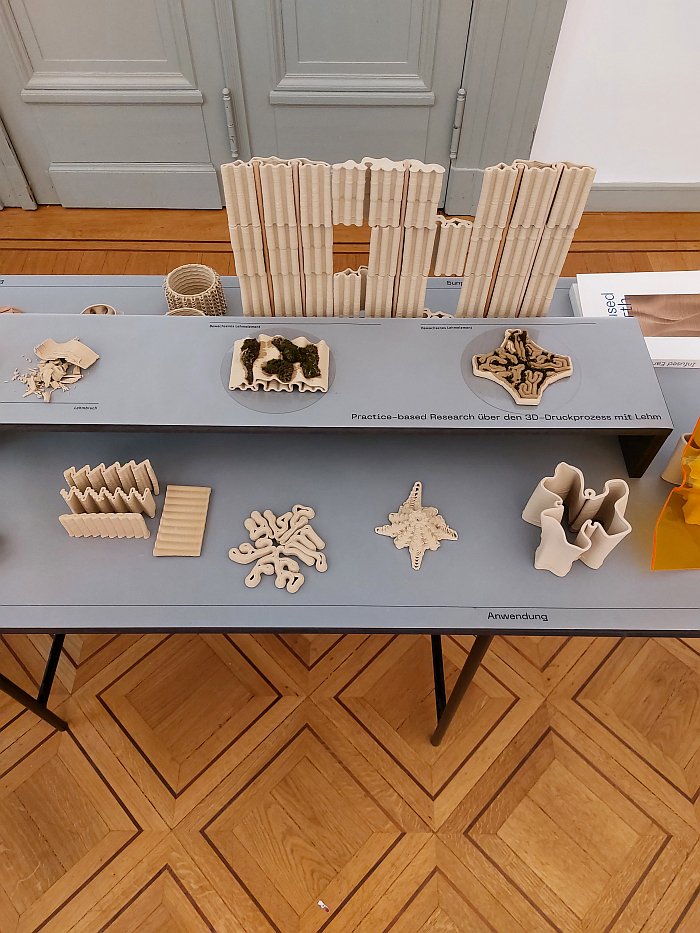As we were preparing for our trip to Halle and the 2023 Burg Giebichenstein Kunsthochschule Jahresausstellung one of those people on the edge of the smow Blog, one of those people who are so important to its operation, asked us how many summer exhibitions we'd seen at Burg Halle.
A question that caused a terror to develop within us as the enormity of the number forming before our eyes became ever more distinct and discernable; but then, before we gave vocal form to such an improbable, hair-raising, number, we regained our composure, "None", we replied, "for similar as each summer exhibition may be, it's always a virgin experience".
Eyes were conspicuously rolled as our questioner walked away, and as we set off for Halle.......

For all that the Burg Giebichenstein Kunsthochschule Halle stands in the artificially overinflated shadow of its former near neighbours Bauhaus Weimar and Dessau, it has unquestionably played every bit as important, and informative, a role in the development of design, in all its contexts, in the contemporary Germany, in the contemporary Europe; starting, in effect, from the appointment in July 1915 of Paul Thiersch as director of the, then, Handwerkerschule Halle, becoming established in the 1920s and 30s, moving on through the tribulations of the DDR decades, and continuing unbroken since the formation of the new unified Germany.
If that importance continues as the world moves forward is very much dependent on the current staff and students, both of whom are very much in the spotlight at any design school summer showcase: the latter through the works on display and the positions and approaches and learning and development embodied therein, the former through the access the projects and set briefs on display allow to questions of how the students are encouraged to develop those positions and approaches, to questions of the understandings of design, and designers, mediated by the school.
Projects and briefs that, as ever at the Burg Halle Jahresausstellung, were very much the focus of the presentation, and which featured, and amongst many, many others, Ins Freie - Into the Open - under the direction of Prof. Matthias Zänsler and Alexander Rex, which challenged the students to develop objects, concepts, systems, et al with the potential to enrich and improve the quality of outdoor activities, outdoor activities that have long been a component of Homo urbanus's existence but which during the Covid years took on, for many, a whole new, and now central essential, role and function, and a project from which our attention was particularly caught by MXV by Nele Meier, an open source pannier rack system that can be individually configured to allow a number of functions, and also by Entsorgen by Mareike Galle, a transportable sun and heat protection system informed by the traditional tents of northern African nomadic communities and, as with those tents, crafted from wool. A project which aside from the promise it offered of the ability to regulate the local-level spatial climate, that thing that is going to become increasingly important in Europe when we go Ins Freie, also appealed to us on the one hand as another very nice example of the application, the adaption, of analogue vernacular technology that has proven its worth in North Africa and the Middle East to and for the future European reality, something also embodied, for example, by the project Fiasco radiatore by Valerio Sampognaro as seen at the 2023 Graduate Show at Hochschule für Bildende Künste, Hamburg, and also by those many examples included in Hot Cities: Lessons from Arab Architecture at the Vitra Design Museum Gallery which we now can't tell you about because they closed it early; and on the other appealed to us because, if produced and distributed on a local level, it exists as a very nice, and aposite, opportunity to not only develop, strengthen, local wool markets and thus enable, empower, a move away from the harmful consequences of contemporary industrial wool farming, but also, and as reflected on in context of Louise Richard's Académie royale des Beaux-Arts de Bruxelles 2022 graduation project MultiFelt – Histoire de pulls, as seen at MAD Brussels, an opportunity to develop and exploit the positive local level economic and social and environmental impacts that more small-scale sheepholding could, possibly, bring. Sheep being, as they are, a lot more than just the wool contemporary industry views them as.

The class Verweilen - Tarry, Pause, Linger, Sojourn - by Prof. Vincenz Warnke and Bastian Thürich which asked the students to develop objects, spaces, practices that enabled, allowed supported a pleasing and meaningful rest, that enable us all to optimally enjoy the thrill of doing nothing and which, and amongst the many interesting responses, saw Lukas Freudenberger propose Urban Cooling Columns, cermaic columns which via the continual water evaporation they enable allow for that aforementioned regulation of the local-level spatial climate, and which as small forests in urban spaces are both an architectural feature and also a reclaiming of the urban space from the negative climatic consequences of human activity; and also saw Anna Freudenberg develop the projects Was Bleibt - What Remains - a project which concerned itself with human composting.......
.......which we didn't know was an actual thing until we saw Was Bleibt; but are now mildly obsessed by. In essence human composting, as the name implies, sees deceased humans turned into compost, a process that, apparently, takes around 40 days, and thus represents a speeding up of a process that is going to happen anyway, certainly if you're buried according to Islamic or Judaic tradition. Christians in metal caskets and full of embalming fluid may not. Anna Freudenberg's take on human composting, her contribution to the debate on human composting, and proposal for a practical application of human composting as a future-resilient alternative to conventional burials and cremations, is, essentially, focussed on what happens after those 40 days, and, specifically, saw Anna develop a reusable coffin-like object which allows for a traditional, Christian, burial, and thereby a maintaining of the rituals and ceremonies of taking leave of a friend and/or loved one, but which through the addition of hummus to the ground rather than a box means you, effectively, create a small garden rather than a grave. A small garden which can be individually planted and thereby maintained as a place of memory of and connection with the deceased; which not only enables a new form of, new rituals for, the mourning of the passing of others but also makes cemeteries less sombre and foreboding places. And also offers the opportunity of rescuing the profession of the Cemetery Gardner, a profession that in recent years has fallen into a steep decline not only through the increase in cremations but also through climate change and the need to develop cemeteries reflective of the new realities. A process human composting can, arguably, positively contribute to; can help dead humans counteract some of the damage we humans cause when alive.

Elsewhere the class My Mould, led by Prof. Laura Straßer and Larissa Siemon, and realised in conjunction with the the Harzkristall glassworks, Derenburg, concerned itself with the tools and processes of glassmaking and which in the project Vases ( ) by Paul Matteo Wesser placed a modular mould at the centre of the concept and thereby enabled a degree of variability, a variability increased by the modularity of the realised objects, from a minimum of tools, and a modular mould less-is-more principle also employed in the ceramics project Convertible Ring by In Lee conceived in context of the class Porcelain Playground, similarly under the direction of Prof. Laura Straßer and Larissa Siemon; and modular moulds which echo the discussion initiated by Glass – Hand Formed Matter at the Bröhan Museum, Berlin, that glass, and porcelain, can remain relevant as handcraft processes, but, arguably, and at the risk of re-igniting the Typisierung Debatte that cased the fission of the Deutsche Werkbund, and at the risk of facing the extreme displeasure of William Morris, need to focus on developing semi-industrial processes, such as allowed by modular moulds, to enable the rapid production of families of objects.
The project Precious Particle by Prof. Mareike Gast, Andreas Wagner & Karl-Johann Schikora in which students busied themselves with novel uses for bead foams, those expanded synthetic materials most popularly understood as styrofoam packaging, but which, as was demonstrated in Halle can be used in numerous contexts, including in the lamp Floppy developed by Bruno Bleschke, Eric Feilee, Franz Kauffmann & Christian Kloß, a lamp we're not 100% certain were 100% convinced by, but which has given us ample food for thought and will, we suspect, nourish us for a while to come.
While in the Textile Design department the class Spazieren by Prof. Bettina Göttke-Krogmannin set the brief of developing an object, a collection, a pattern, an installation, a whatever from an analysis of observations made while spazieren, strolling, through a specific location, and thus a very nice application of a Lucius Burckhardt's Spaziergangswissenschaften to the design process and thereby a reminder of the fact that the solution you're looking for, whatever the professional/personal problem is, may be at hand, you've just got to be open to seeing it, rather than viewing the world through established frameworks and registers. Or the class Scale Up! instigated by Kristin Nebauer which focussed its attention on carpets, and specifically, and summarising dangerously, carpets as physical and emotional components of a space, on carpets as more than just a passive piece of textile on which you stand, carpets as functional beyond the warmth they bring or the cold they keep at bay; and a brief whose responses included Gradient by Elisa Bannasch, a project which, amongst many other interesting and informative aspects, through its employment of multi-coloured wools brushed into voluminous yarns helps indicate how relevant a Bernat Klein remains, and also helps elucidate the functional role of colour in defining a space. And also included Floating Wool by Stella-Marie Höllerer which proposes using carpets of wool to remove, suck, oils and fats from the surface of water; as Stella-Marie notes such a system doesn't necessarily stop water pollution, for that we need to stop putting pollutants in water, but, again as Stella-Marie notes, as an installation, and a demonstration, can help highlight and increase sensibilities to the levels of such fats and oils in water, how they got there, and how we can keep them out, while, we'd argue, as a concept it can also also be used not only for soaking up oil spills at home, but also as low-impact method to remove all the oils that invariably exist in public outdoor swimming pools and managed lakes in the summer months thanks to sun-creams et al. If we are admittedly unsure about the subsequent disposal of the oil/fat saturated wool, at least if the oils and fats are to be kept out of the environment. In addition, and returning briefly to Entsorgen by Mareike Galle and to MultiFelt – Histoire de pulls by Louise Richar, the development of such a wool based oil/fat removal system is a further encouragement to the development of more local small-scale sheepholding by way of supporting low-tech, low-cost, local production.

Alongside such, and a great many other semester projects, the 2023 Burg Halle Jahresausstellung also presented, as is custom, this year's Bachelor and Master graduation projects from which were particularly taken by the project Infused Earth by Marianne Sellmaier which investigated the processes, particularities, properties and possibilities of 3D printing with mud, a material that has been successfully used for construction for centuries, as we could tell you if the Vitra Design Museum hadn't prematurely closed Hot Cities, and a material which is also currently 3D printed, including, as noted from PRINT3D. Reprint Reality at the CaixaForum, Sevilla, for the 3D printing of houses, a comparison we could have made had Hot Cities continued, as planned, till November; but which is a material that is very much still needing its borders pushed, is still needing to be explored, projected, broken in a much wider variety of contexts and scales in order that it can be better determined to what degree it can be the future-resilient material it appears to promise be. And that for all in context of 3D printing, a novel technology that itself offers interesting, exciting, options for the future and for which that most ancient of materials, mud, appears to be a near perfect material; projects such as Infused Earth are an important part of that learning process, and also helps underscore that design isn't just about developing objects. Despite what the autocratic Influencers of Instagram tell you.
An underscoring of the scope and complexity of design, and of a designers responsibilities beyond increasing the profits of manufacturers, reinforced by This is (not) my chair by Jacobo Cuesta Wolf a project which, very satisfyingly, very very satisfyingly, understands furniture not as objects to be consumed and used, but as components of a ongoing production, use, disposal, reuse system, understands an object of furniture not as end but as moment in a process. An inevitable process. Arguably a desired process. Based around eight, if one so will, and for want of a better phrase, principles to enable a meaningful circular furniture usage, including, for example, ensuring an efficient use of materials, the possibility to reform and reshape an existing object and also visual longevity, that trickiest of issues in a human society that increasingly places such an exaggerated importance on visuals, on the short-term, transient, styling that so annoyed a Karl Clauss Dietel, and which was, we'd argue, an utter indifference to a Charles & Ray Eames, This is (not) my chair saw and sees Jacobo on the one hand develop a connection system that allows for the creation, and continual re-imagining, of a wide variety of furniture objects from a family of components, and which as such has very nice echoes of the OpenStructures project founded by Thomas Lommée, also in its considerations on decentralised production, and on the other hand critically reflects on the processes of production, distribution, repair, recycling etc as practised by the furniture industry, including discussing the possibility of the increased use of renting rather than buying furniture. And as such is a project which unequivocally admonishes that creating a sustainable, responsible, furniture industry is about a lot more than just recycled plastics, compostable materials and sustainably harvested woods, but involves a fundamental questioning and re-imaging of all aspects of furniture production, distribution, retail, marketing, and design, and for all involves changing our perspectives on what furniture is. A process that, arguably, began in the late 19th-century, but which the quickest of glances at the contemporary furniture industry tends to imply is in danger of stalling, with all the negative consequences that will bring with it.

In addition the 2023 Burg Giebichenstein Kunsthochschule Halle Jahresausstellung presented, and as ever amongst a great many other showcases, projects from the BurgLabs, that research platform probing questions of sustainability, artificial intelligence, robotics and also the biotechnology that was the focus of the 2023 presentation; the works of the life art class, Burg Halle being one of ever fewer design schools that include life art in their curriculum, and a presentation which reminded that, thankfully, Burg Giebichenstein is in Halle (Salle) not Halle (Florida) where such a display of human flesh would see all participants denounced as pornographers and imprisoned. Possibly.
And also presented that staple of design school education: the first year, foundation course, class in which students taking things apart, measure them and then rebuild them in a different context, material, scale etc, by way of learning about relationships, proportions, geometry, processes, perspectives, statics etc. A class is that is omnipresent, is always a delight and, in many regards, traces its (hi)story back to the earliest days of design education when students initially copied that which existed, much as art students have for centuries, before it became the creation of abstract objects embodying specific characteristics and qualities, and ultimately the contemporary combination of both. Which as such is a lovely analogy of how design has developed. And a class represented in Halle by the projects Wachs-en in which plastic containers were to be studied and then recreated in wax, and thereby also allowing practical experience in wax modelling; Fahrradfahren und Einschenken in which, and irresponsibly over-summarising, adjectives associated with riding a bicycle were employed to create an object embodying that motion. And by the simply delightful Äpfel - Apple - in which students had to study an apple and then create a paper model of that apple. And if you think that sounds easy, have a go yourself.
And thereby all allowing the 2023 Burg Halle Jahresausstellung to confirm that any design school's summer exhibition is always a case of same same but different. Which is just one of the many reasons we should all visit as many as regularly as possible.
Full details on the Burg Giebichenstein Kunsthochschule Halle can be found at www.burg-halle.de
As ever, not mentioning a project doesn’t mean we didn’t like it, just means time and space are limited, apologies to all the unnamed. And as ever we may have missed things, in fact we know we did, again apologies, but if it's meant to be we will meet it eventually, promise.......







